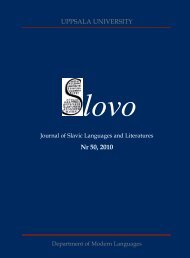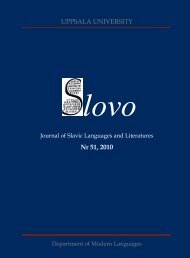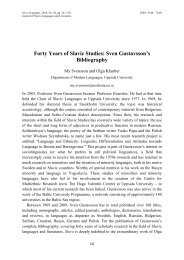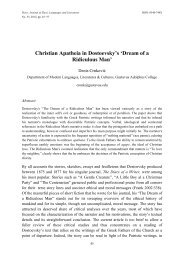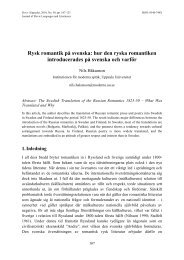Full text PDF - Index of - Uppsala universitet
Full text PDF - Index of - Uppsala universitet
Full text PDF - Index of - Uppsala universitet
Create successful ePaper yourself
Turn your PDF publications into a flip-book with our unique Google optimized e-Paper software.
Atle Grønn<br />
‘Byvalo’ and ‘used to’ as verbal quantifiers<br />
(40) Deto pomineše[up/uipf, upf] našija tren, šapki zachvărčavacha nagore.<br />
(Bulgarian)<br />
‘Wherever our train passed by, hats would be thrown in the air.’ (cited from<br />
Mønnesland 1984:68)<br />
6. Analysis<br />
Returning to our initial example (1)–(2), repeated below, I shall now sketch a formal<br />
analysis:<br />
(41) Всё, бывало[up, uipf], с ней через забор разговариваю[un, uipf]. (Anton<br />
Čechov, “Baby”)<br />
(42) I used[up] always to be talking[uipf] to her across the fence.<br />
Byvalo or used to give us a large interval in the past, and furthermore, quantify over<br />
subintervals <strong>of</strong> the past time span. The truth conditions for the above sentence could be<br />
paraphrased as follows (slightly modified after Paslawska & von Stechow 2003;<br />
Scheiner 2002):<br />
(43) There is a past time t such that the speaker has the habitus s at a superinterval<br />
<strong>of</strong> t and such that for all con<strong>text</strong>ually relevant subintervals t’ <strong>of</strong> s, events e <strong>of</strong><br />
the speaker talking to her are instantiated at superintervals <strong>of</strong> t’.<br />
(44) t s. [t < now & t s & (t’) [con<strong>text</strong>ually_relevant(t’) & t’ s e [t’ e<br />
& talking to her(e)]]]<br />
Without going into the details <strong>of</strong> the semantic composition, I propose the following<br />
semantic skeleton for the constructions involved in this paper:<br />
[TENSE[IMP[HAB-byvalo/used [ZERO TENSE [LOWER ASPECT[verb]]]]]]<br />
ip up in un<br />
|________________|<br />
|__________________________|<br />
Figure 4. Semantic skeleton <strong>of</strong> habituals and licensing condition for the present tense in Russian.<br />
In fact, in the Russian example (41), all the semantic ingredients involved are<br />
morphologically expressed: the morphology <strong>of</strong> the habitual operator byvalo points to<br />
both a tense operator (here: PAST) and the imperfective aspect (the suffix -yva). The<br />
embedded verb razgovarivaju is semantically tenseless (zero tense), but<br />
morphologically marked for the present tense in accordance with the SOT parameter.<br />
And, finally, the verb is marked with the imperfective aspect reflecting the process<br />
interpretation <strong>of</strong> the embedded talking events. 11<br />
11 As shown in the examples above, we can have either the imperfective or perfective aspect under byvalo. This<br />
also holds for other verbal quantifiers such as the subjunctive by, but not for the future shifter budet, which<br />
subcategorizes for imperfective verbs.<br />
73



